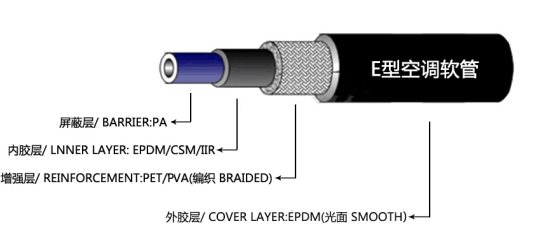r134a service hose
Understanding R134a Service Hoses
In the realm of automotive maintenance and air conditioning service, R134a service hoses play a crucial role in ensuring efficient refrigerant transfer. R134a, a hydrofluorocarbon refrigerant, has been widely adopted in automotive air conditioning systems due to its low ozone depletion potential and effectiveness in heat transfer. To maintain these systems effectively, the appropriate service hoses are essential.
What Are R134a Service Hoses?
R134a service hoses are specialized hoses designed to connect the manifold gauge set to an automotive air conditioning system. These hoses facilitate the transfer of R134a refrigerant during charging, evacuating, and diagnosing issues within the air conditioning system. Typically, these hoses are color-coded blue for the low-pressure side, red for the high-pressure side, and yellow for the refrigerant recovery or charging line.
Importance of Quality Service Hoses
Using high-quality R134a service hoses is paramount for the longevity and functionality of the AC system. Substandard hoses can lead to leaks, which not only result in refrigerant loss but can also impact system efficiency and contribute to environmental issues. Moreover, quality hoses are designed to withstand high pressures, resist wear and tear, and feature durable fittings that ensure a secure seal during operation.
Features to Look For
When selecting R134a service hoses, there are several critical features to consider
1. Pressure Rating Ensure that the hoses meet the necessary pressure ratings for R134a systems. A typical operating pressure can exceed 200 psi, so hoses should comfortably handle these levels.
r134a service hose

2. Construction Hoses constructed from high-quality materials such as nylon-reinforced rubber or flexible thermoplastic offer better performance and durability.
3. Length and Flexibility Depending on your workspace, the length and flexibility of the hoses can significantly impact ease of use. Longer hoses provide more reach, while flexible hoses allow for easier maneuverability in tight spaces.
4. Fittings Ensure that the fittings are compatible with your equipment and feature a secure locking mechanism to prevent accidental disconnections.
Maintenance and Safety Tips
Proper maintenance of service hoses extends their lifespan and ensures safe operation. Regularly inspect hoses for cracks, wear, or leaks, and replace them as necessary. Always handle refrigerants with care, using gloves and safety goggles, and ensure that the workspace is well-ventilated to avoid inhaling harmful vapors.
Additionally, familiarize yourself with the correct procedures for charging and evacuating an AC system. This knowledge not only prevents accidents but also helps in achieving the optimal performance of the air conditioning system.
Conclusion
R134a service hoses are vital components in the maintenance of automotive air conditioning systems. Investing in high-quality hoses, understanding their features, and adhering to safety practices can enhance the efficiency of service operations and ensure the longevity of your AC system. Proper care and handling of these hoses not only promotes a cooler driving experience but also contributes to environmental sustainability by minimizing refrigerant leaks.
-
Ultimate Spiral Protection for Hoses & CablesNewsJun.26,2025
-
The Ultimate Quick-Connect Solutions for Every NeedNewsJun.26,2025
-
SAE J1401 Brake Hose: Reliable Choice for Safe BrakingNewsJun.26,2025
-
Reliable J2064 A/C Hoses for Real-World Cooling NeedsNewsJun.26,2025
-
Heavy-Duty Sewer Jetting Hoses Built to LastNewsJun.26,2025
-
Fix Power Steering Tube Leaks Fast – Durable & Affordable SolutionNewsJun.26,2025

